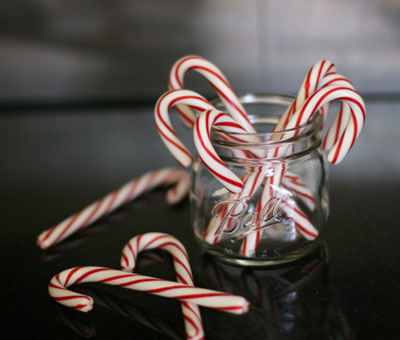Handy Dandy Candy Canes
By John DiGilio in Food on Dec 27, 2010 4:30PM

The old adage says that Christmas comes but once a year. The same is true of one of the holiday's most visible symbols - the candy cane. The history of this yuletide treat is mired in debate and steeped in mythology. Now that the holiday is behind us, they will be on sale far and wide as grocers scurry to clear out the Christmas stock in time for beachwear and summer specialties. What better a time then to talk about candy canes than now?
Despite a lot of claims about Christian symbolism and American origins, historians actually trace the origins of the candy cane back to the 17th century where candymakers took great pains to handcraft sticks of sugar. If, at the same time, they began bending the sticks into the cane shape we now know and love is uncertain. Popular belief says it was a choirmaster in Germany who first had the canes shaped into a shepherd's hook. Supposedly, he used them as incentives to keep the children behaved in church. Whether the hook was actually intended to symbolize the Christian shepherd or simply make it easier to use them as decorations will probably never be known.
What we do know is that the modern candy cane with its red and white stripes did not appear until much later. Prior to the 1900, historical images show the candy cane as a pure white confection. It was not until after the turn of the 20th Century that we see candy canes depicted with their familiar barbershop pole striping. Mass production in America followed soon after and history took care of the rest. Today, you can find them by the thousands in grocery and drug stores everywhere. They come in various sizes, colors, and even flavors. Christmas wouldn't be Christmas these days without candy canes.
From the minty to the fruit-flavored, red and white to rainbow, candy canes can be put to a plethora of uses. Some people use them as Christmas decorations and ornaments. Others simply eat them as they are. In fact, skip the breath mints and stick a peppermint candy cane in your mouth. It will freshen you right up. The mint-flavored ones also make excellent stirrers for coffee and hot cocoa. Crush them finely and sprinkle them on ice cream or mix them into white cake frosting for a fun and festive accent. One of our favorite recipes is Martha Stewart's own Peppermint Bark. Using just three ingredients, it creates an inexpensive and tasty post-holiday treat.
There is so much you can do with seasonal treats. Take down the tree and put away the decorations, but do not throw out the leftover candy canes. Grab a couple of clearance priced boxes if you can and put them in the pantry. It's not like they go bad. Sure, Christmas itself may come once a year. But with some spare candy canes on hand, you can spread a little of the holiday flavor from one yule to the next.
Photo by Eliza Domestica